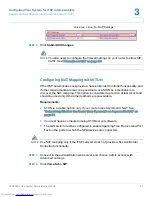
3
SPA9000 Voice System Administration Guide
47
Configuring Your System for ITSP
Interoperability
This chapter provides configuration details to help you to ensure that your
infrastructure properly supports voice services.
•
“About the SPA9000 Voice System and SIP,” on page 47
•
“Network Address Translation (NAT) and Voice over IP (VoIP),” on page 49
•
“Firewalls and SIP,” on page 54
•
“Configuring SIP Timer Values,” on page 55
About the SPA9000 Voice System and SIP
The SPA9000 Voice System is implemented using open standards, such as
Session Initiation Protocol (SIP), to help ensure interoperability with all ITSPs that
support SIP. This section provides information about the SIP requests and the
settings that you may need to adjust on your network or your SPA9000 to help
ensure interoperability.
The VoIP telephone service is coordinated by SIP requests and responses,
whether the calls are internal or external.
Figure1, “SIP Requests and Responses
for Internal Calls,” on page 48
illustrates the SIP requests and responses between
client stations in the SPA9000 Voice System. The SPA9000 acts as a SIP proxy
and establishes a session. After the session is established, Real Time Protocol
(RTP) traffic flows directly between the two client stations.
Downloaded from
www.Manualslib.com
manuals search engine
















































